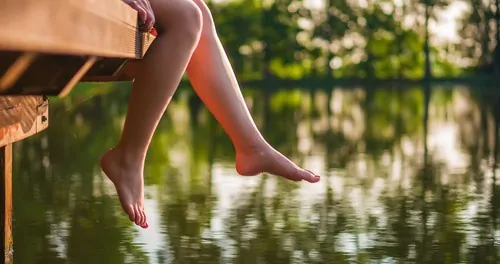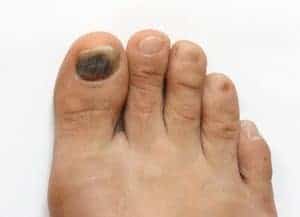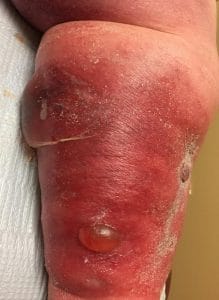Blood Blister on Foot

Blood Blister
While most of us experience a blood blister sometime in our life, it’s worth explaining the sports medicine behind them. Blood Blisters and regular blisters occur when friction tears the top layers of skin, leaving a bubble between the healing layers of skins. While there is not much you can do to remedy an already formed blister (sorry!), you can take preventative measures by ensuring your footwear is properly fitted and that you always wear a good pair of socks. If a blister does appear, you will want to take precautions to make sure it heals properly. Applying a Band-Aid or gel can help reduce further friction.

Blood Blister Under the Toenail
Venous Leg Blisters
Patients with venous reflux can get large blisters on their leg, which left untreated can easily get infected. These can sometimes become blood blisters if the delicate tissue tears.
Other Diagnosis
Eczema
The first step in treating any skin problem is an accurate diagnosis. Only then can we hope to prevent it from occurring again. It can be quite difficult to diagnose eczema. Being a chronic skin condition, it can resemble a variety of other skin problems. To insure a speedy and correct diagnosis, it’s important to consult with a knowledgeable and experienced dermatologist. With first class training, the newest technologies and years of experience, we can help you manage your eczema so that the instances of this painful skin disorder will become less common and intense.
When you first visit our office, one of our highly-trained medical professionals will complete an intake interview. Our goal is to get a clear picture of your medical background, family history and your current symptoms including a timeline. It can help to write down a synopsis of what you’ve been experiencing and any questions that you have before coming in for your appointment. After that, a physical exam will be conducted. The most common symptom associated with eczema is Itchy skin. The compulsion to scratch may be so powerful that some patients find it impossible to control themselves. Some sufferers even scratch without being aware of it. Further irritating a lesion by scratching or picking at it can result in scarring and other complications.
Different in everyone
Eczema can present differently in individual cases. Its symptoms can be easily confused with other skin disorders, such as contact dermatitis (which is a reaction to a chemical that can irritate the skin), psoriasis, or hives. Eczema has several tell-tale signs. Your dermatologist may consider an eczema diagnosis if your skin presents with any of the following symptoms:
- bleeding,
- blistering,
- cracking,
- crusting,
- discoloration,
- flaking,
- itchy skin
- oozing,
- redness or
- swelling.
Eczema could be responsible if you are experiencing any of these symptoms on an ongoing or recurring basis.
As eczema can present with similar symptoms to other skin conditions, collecting a thorough medical history (including your family history) is central to a good diagnosis. While the exact cause of eczema is here to unknown, most medical professionals believed that this skin disorder is caused by a combination of genetic and environmental factors.
How Are Blood Blisters Treated?
You don’t have to worry about your blood blister, they won’t do anything until you don’t interfere with them.
Most of the time blisters should be left alone since they will heal on their own, they won’t need a treatment mist of the time.
Gradually the liquid inside blood blister will dry out and your skin will look normal just like it what it used to look like.
This process will take at least one or two weeks, therefore be patient and wait until your blister doesn’t heal.
If you are concerned about your blister then you can provide it with an extra layer of protection. You should use a bandage for it.
Avoid friction in that area and protect it, if your blister hurts then try to apply ice, it can help you desk with the discomfort.
You should keep the area clean and change your bandage once it gets dirty, this will prevent invasive of germs.
When Should I Look For A Doctor?
Just like mentioned before blood blisters aren’t something you should worry about.
In many, blood blisters are formed after excessive rubbing or your skin against some object like shoes. However, there are some signs that tells you it’s time to find a doctor to treat your blister.
If you notice any of these signs then visit your doctor as soon as possible:
- It’s hard for you to use your hand or blister makes it difficult for you to walk
- You have been facing blisters again and again.
- Blisters are appearing in your eyelids or mouth.
- If blisters show symptoms of infection
- Blisters have red lines that are going away from it.
- They have appear suddenly without any reason
- You experience bleeding or pus comes out of the blister.
- You can’t figure out why there are so many blisters on your body.
How can I prevent scarring from a blood blister on my foot?
To prevent scarring from a blood blister on your foot, follow these steps:
1. Avoid Popping: Do not pop the blood blister, as this can increase the risk of infection and scarring.
2. Keep it Clean: Keep the area clean and dry to prevent infection. Use mild soap and water to gently clean the blister and surrounding skin.
3. Protect the Blister: Cover the blister with a sterile, adhesive bandage or dressing to protect it from further irritation.
4. Avoid Pressure: Avoid putting pressure on the blistered area to prevent it from bursting.
5. Wear Proper Footwear: Wear comfortable, properly fitting shoes to prevent friction and irritation on the blistered area.
Can blood blisters on the foot be a sign of a more serious condition?
In most cases, blood blisters on the foot are not a sign of a serious condition and are often caused by friction or trauma to the skin. However, in some cases, blood blisters on the foot can be a symptom of an underlying health issue, such as:
1. Infection: If a blood blister becomes infected, it can lead to complications and may indicate a more serious infection that requires medical attention.
2. Blood Disorders: In some cases, frequent or unexplained blood blisters may be a sign of a blood disorder or clotting disorder.
3. Skin Conditions: Certain skin conditions, such as bullous pemphigoid or dermatitis herpetiformis, can cause blisters, including blood blisters.
4. Allergic Reactions: Severe allergic reactions can sometimes cause blood blisters as part of the overall reaction.
Can I exercise with a blood blister on my foot?
It’s generally best to avoid vigorous exercise that puts pressure on the blood blister to prevent it from bursting and becoming infected. Low-impact activities like swimming or cycling may be more suitable. Ensure the blister is protected with a bandage or cushioned dressing before
exercising.

